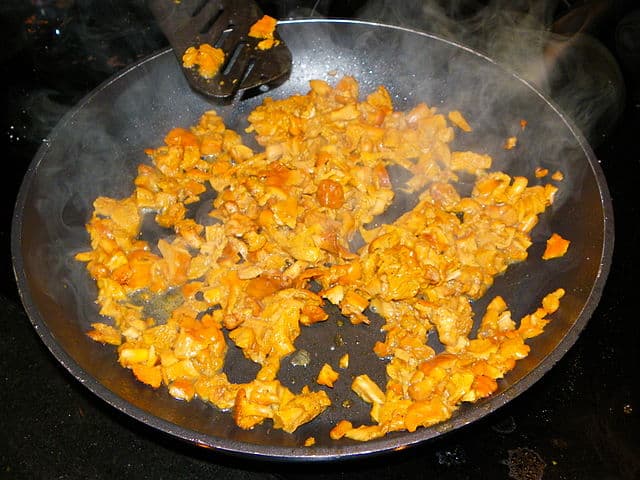
Tips for Cooking Chanterelles
Like most wild edible mushrooms, chanterelles cannot be safely eaten raw. Doing so can cause some nasty gastrointestinal upset. Always make sure you cook your chanterelles thoroughly before eating them. If you’ve never eaten chanterelles before, cook and eat a small amount first, and then wait a day to make sure you don’t have any allergic or other adverse reactions to them.
Because chanterelles have a lot of moisture in them, it’s possible to make them too mushy when cooking them. A good way to remove some of this extra moisture is through dry sauteeing. Chop or slice the chanterelles you’re going to use, then put a pinch of salt in a pan over medium-high heat. Add the chanterelles, then keep them moving around the pan until excess liquid leaves them. Once the liquid has cooked off entirely and the pan is dry again, you can then use the chanterelles in recipes.
Simple Sautees and Duxelles
The simplest way to cook chanterelles is to sautee them in butter or oil. Put the butter or oil in a pan over medium-high heat; you can add garlic or other seasonings if you like. Keep them moving until they are cooked through. Eat them as-is, or serve over rice or pasta with a little more oil or butter. Be aware that if you have dry sauteed them first they may cook much more quickly than if they were dropped into the oil or butter raw.
A more complex form of sauteeing is duxelles. Start by chopping your chanterelles as finely as you can; you can pulse them in a food processor if you prefer. Finely chop one to two shallots (yellow or white onion can be substituted), one to three garlic cloves, and enough parsley to make about a tablespoon of chopped leaves. Cook the garlic and shallots in three or four tablespoons of butter in a pan on medium heat for about three minutes, then add the mushrooms and cook an additional five minutes, keeping everything moving the whole time. Raise the heat to medium-high, and continue to cook until excess moisture has cooked off. Remove from heat and add in the parsley. Duxelles may be served over various meats, pasta, eggs, rice, potatoes, etc. They can also be frozen in air-tight containers like freezer or vacuum bags to be used in the future.

Soups, Quiches, and More
If you’re a fan of soup, you’re in luck! Those sauteed chanterelles make a great base for a soup. Get a heavy-bottomed soup pot, and sautee a pound of chanterelles as per above along with one small white or yellow onion, chopped; add garlic to taste. Once the mushrooms are cooked through, add a quart of chicken stock (or a vegetarian alternative); chop half a dozen baby potatoes and add them to the soup, along with any other seasonings you prefer. Bring a boil, then simmer until potatoes are cooked through. Add a cup of cream, cook until warmed through, then serve.
Chanterelles also lend themselves well to the filling in savory tarts and quiches. Any recipe that calls for mushrooms should work well for chanterelles. The same goes for mushroom gravy; keep the recipes simple so that that chanterelle flavor shines through. A cream-based sauce or gravy works especially well for these tasty mushrooms.
—————
Written by Rebecca Lexa
Rebecca Lexa is a certified Master Naturalist in the Pacific Northwest. She teaches classes on foraging and other natural history topics, both online and off. More about her work can be found at http://www.rebeccalexa.com.
Many of our readers find that subscribing to Eat The Planet is the best way to make sure they don't miss any of our valuable information about wild edibles.
See our privacy policy for more information about ads on this site






